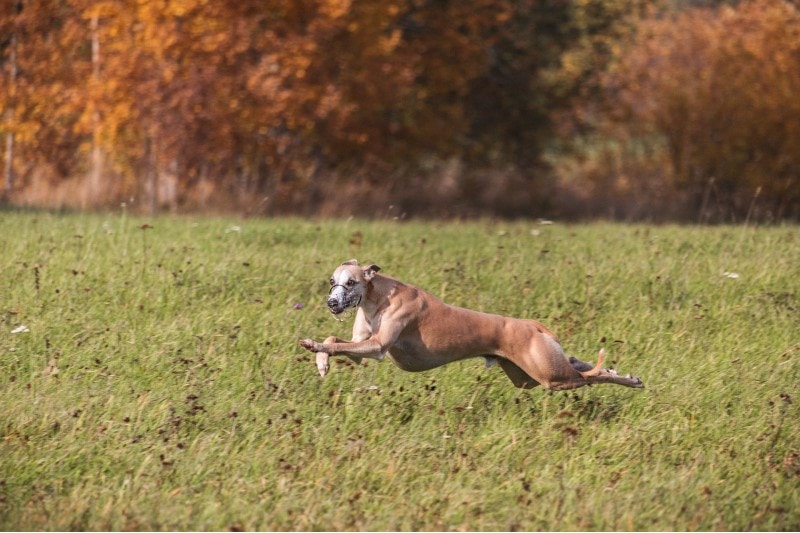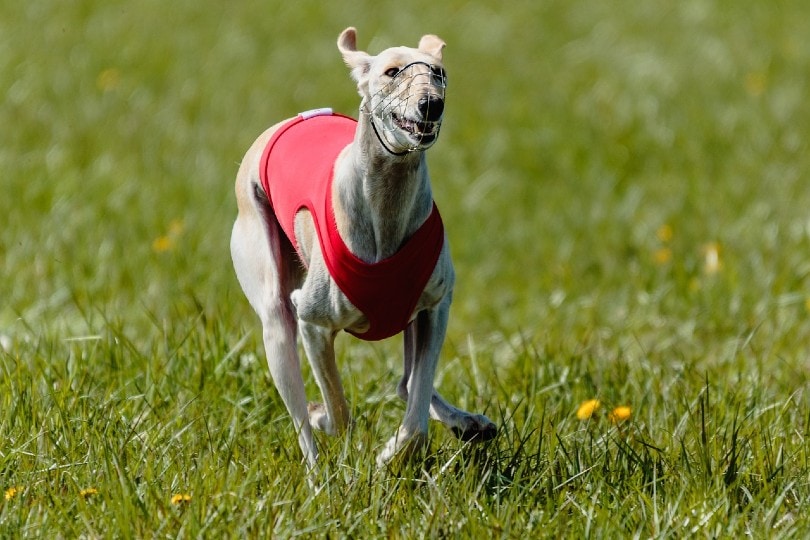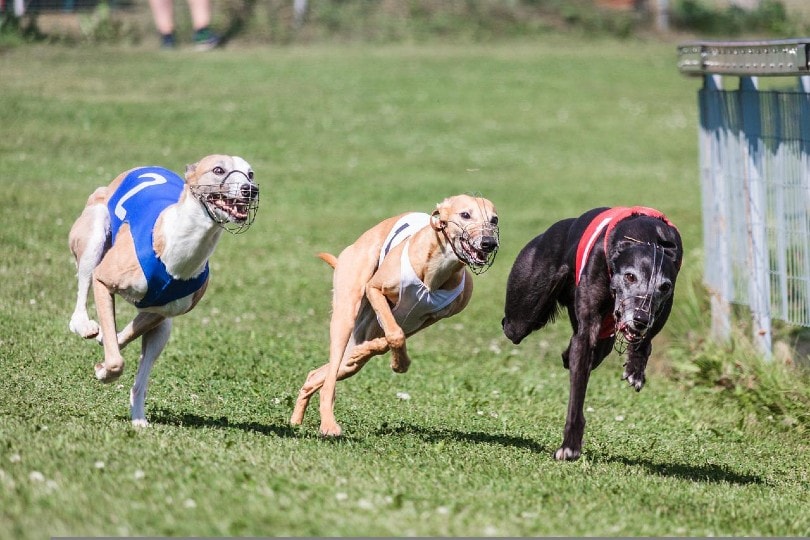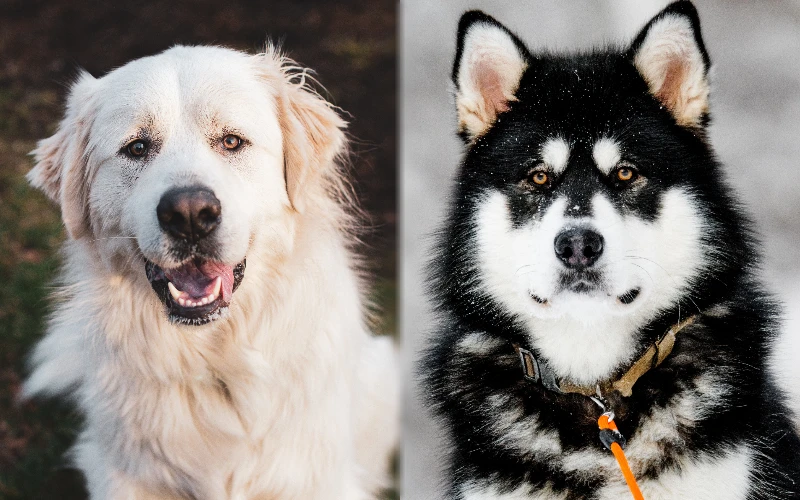How Fast Can a Whippet Run? Speed Comparison & FAQ

Updated on

The Whippet’s graceful form is hard to miss when you see one in public, but once these dogs take off running, they’re almost impossible to spot. Built like canine dragsters, Whippets are aerodynamic and lightning-fast. The powerful pups are prized runners, often reaching speeds of up to 35 mph!
With the Whippet’s propensity for racing, leaving them out of competitive sports is almost a disservice. Discover the potential in this graceful breed as we look at how fast a Whippet can run.
Whippets Are the Ultimate Competitors
Whippets are more than the canine world’s athletes; they’re its champions. There’s no speed sport where these pups can’t succeed, and their air-cutting forms and turbo-charged legs take them places most dogs can only imagine. The air becomes electric when it’s the Whippet’s turn, and crowds invariably expect amazing things from their performance.
Though smaller than the Greyhound, the breed’s finest athletes are consistent winners in numerous racing, jumping, and agility disciplines. Individuals like Spitfire, a champion dock-diving Whippet dubbed the “Michael Jordan of Dogs,” represent the untouchable heights and speeds these dogs can reach.
Owning five world records and two world championship titles, Spitfire wins with his uncanny ability to accelerate and launch distances of over 31 feet. He’s only one of several success stories within the breed but arguably the finest example of their superior fitness.
How Fast Can a Whippet Run?
| Species | Speed |
| Cheetah | 75 mph |
| Quarter Horse | 55 mph |
| Kangaroo | 44 mph |
| Whippet | 35 mph |
| House Cat | 30 mph |
| Rabbit | 25 mph |
| Humans | 10 mph |
Whippets can’t touch the pace of larger breeds like Salukis, Vizslas, or Greyhounds, which can reach top speeds of 45 mph. Alongside the Jack Russell Terrier, they may be the speediest dog pound for pound. As the fastest accelerating dog breed, Whippets excel in sports like dock diving, flyball, flying disc, and speed trials. And Spitfire isn’t alone in proving how these dogs dominate the competition.
A Whippet can run up to 35 miles per hour. In 2022, Whippets were the two quickest dogs at the Fastest Dogs USA 100-yard competition and the AKC’s Fast CAT Invitational. Reas, a white-and-blonde male, took the top time of 5.816 seconds (~35.17 mph) at the Fastest Dogs USA competition. Less than a year earlier, he won the 2021 Fast CAT, posting a blistering speed of 5.769 seconds.
Whippets are long-time staples on the leaderboards. With a look at their build and background, it’s easy to see why these pups are speed specialists.
What Makes a Whippet Fast?

The Whippet appeared as a distinct breed in the mid-1800s, and they’re crosses between Terriers and small Greyhounds. The aptly named “poor man’s racehorse” was born to run; they were suited for the circuit and a sure bet for the blue-collar workers who raced them.
What is it that makes the Whippet so fast? The sighthound heritage perfectly blends power, endurance, and aerodynamics. Their lengthy legs carry them vast distances with each stride, while the slender frame and narrow snout cut down on wind resistance.
The deep-chested dogs have excellent lung capacity to resist fatigue. With little unnecessary bulk, their light frames are easy to move far and fast. And thanks to the sighthound’s prey drive running in their genes, Whippets are extra-motivated to give chase in a lure competition.
The Whippet’s Running Style
Alongside their naturally advantageous build, Whippets develop speed from their gait. Like other sighthounds, they use a double suspension gallop to maximize speed. In this four-time, asymmetrical style, all four feet elevate off the ground two times in a single stride.
The first suspension occurs when the Whippet extends the rear legs back and front legs forward in a Superman-style stretch. The front feet then catch the ground on the landing, immediately moving towards the dog’s rear as their body catches up. The dog simultaneously arches their back and pulls their hind legs forward until they are in front of the front paws.
After momentarily being airborne in this position (the second suspension), the hind legs catch the ground. With loads of power and momentum behind them, the rear legs can propel the Whippet into the next stride.
Gene Variations and Running Potential
Not all Whippets are equally capable speedsters, and their success in competition largely hinges on a specific genetic trait. Whippets often display a mutation in the MSTN gene that codes for myostatin, a protein affecting musculature. In wild-type Whippets, the MSTN gene produces myostatin as normal to limit skeletal muscle growth, giving us the dog’s slender form.
In some Whippets, one or both copies of the MSTN genes they receive from their parents can have a mutation, creating a stunted version of myostatin. With a reduced ability to control muscle growth, dogs can become much bulkier than expected.
When a Whippet receives a mutated copy of the MSTN gene from both parents, it develops a double-muscled “Bully” body type. The mutation responsible for the Bully is unique to Whippets and does not appear in any other sighthound, including the Greyhound.
The Bully Whippet’s massive muscles make them unsuitable for racing. But while two mutated genes cause the burly phenotype, Whippets with only one copy of the mutation show mild physical manifestations. Though still svelte, these dogs are more muscular than Whippets with normal MSTN genes and much faster, giving us the racing types we often see atop the podium.

Bully Whippet Syndrome
Interestingly, since a single mutated MSTN gene is the secret ingredient to making a fast-racing dog, Bully Whippets are becoming more common as breeders have inadvertently aimed for dogs with these specific genetics. When two of these “carrier” Whippets breed, half of their offspring will have racing-optimized bodies, but a quarter of their offspring will be Bullies.
Bully Whippets may look fit, but they can struggle mightily with numerous health issues. Weighing nearly two times more than standard Whippets, their bodies sometimes can’t manage the larger muscles efficiently, adding stress that can lead to eventual cardiac or pulmonary issues. The chances of premature death are subsequently higher.
How Far Can a Whippet Run?
The Whippet’s endurance and flexible build allow them to run extensive distances without tiring or getting injured. But their willingness to bolt makes them natural sprinters. Rather than pace themselves for long distances, they erupt in a sprint. A well-paced and disciplined Whippet can run five miles or more, but an excited dog giving chase may only have the stamina or attention span to run a couple of miles.

Conclusion
Whippets are some of the fastest dogs you’ll witness and a dazzling delight whenever they perform. Racing along at speeds nearing 40 mph, they’re a picture of elegance and pure athletic form. But besides their capacity in competition, they’re equally affectionate with family and loyal to a fault. While anyone can appreciate the Whippet’s speed, it’s only one of the many magnificent traits that make them an absolute joy inside and outside the home.
Featured Image Credit: Aleksandr Tarlõkov, Pixabay












